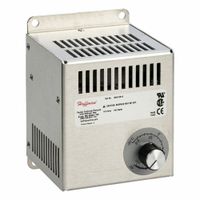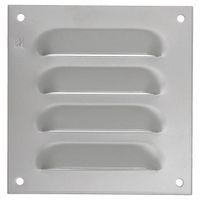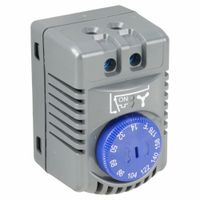Call +(254) 703 030 000 / 751 483 999 / 721 704 777
- Home
- Electrical
- Electrical Boxes Enclosures
- Electrical Enclosures Accessories
- Temperature Controls For Enclosures
.....Read More
Frequently Asked Questions
What are the best temperature control solutions for electrical enclosures?
The best temperature control solutions for electrical enclosures include:
1. **Thermostats and Hygrostats**: These devices monitor and regulate temperature and humidity levels, ensuring optimal conditions within the enclosure.
2. **Fans and Blowers**: These are used to circulate air within the enclosure, preventing hotspots and ensuring even temperature distribution. They are ideal for environments where the ambient temperature is lower than the desired internal temperature.
3. **Air Conditioners**: For enclosures in high-temperature environments, air conditioners provide precise temperature control by cooling the air inside the enclosure. They are suitable for sensitive equipment that requires stable conditions.
4. **Heat Exchangers**: These devices transfer heat from the inside of the enclosure to the outside, using ambient air or a liquid medium. They are efficient in environments where the external temperature is lower than the internal temperature.
5. **Heaters**: In cold environments, heaters maintain the internal temperature above the minimum operating level of the equipment. Options include strip heaters, fan heaters, and PTC heaters.
6. **Vortex Coolers**: These use compressed air to generate cold air, providing a cooling solution without moving parts. They are suitable for small enclosures and hazardous environments.
7. **Thermoelectric Coolers**: Utilizing the Peltier effect, these solid-state devices provide precise temperature control without refrigerants, making them environmentally friendly.
8. **Ventilation Louvers**: These passive solutions allow natural airflow, helping to dissipate heat. They are effective in non-dusty environments with a significant temperature difference between inside and outside.
9. **Insulation**: Proper insulation helps maintain internal temperatures by reducing heat transfer between the enclosure and the external environment.
Selecting the appropriate solution depends on factors like ambient conditions, enclosure size, equipment sensitivity, and energy efficiency requirements.
How do heaters protect electrical enclosures from freezing?
Heaters protect electrical enclosures from freezing by maintaining an internal temperature above the freezing point, preventing condensation and ice formation. They work by converting electrical energy into heat, which is then distributed throughout the enclosure. This process ensures that the components inside remain at a stable temperature, safeguarding them from the adverse effects of cold weather.
The heaters are typically equipped with thermostats or temperature sensors that monitor the internal temperature and activate the heating element when the temperature drops below a set threshold. This automatic regulation ensures energy efficiency by only using power when necessary.
There are various types of heaters used for this purpose, including strip heaters, fan heaters, and PTC (Positive Temperature Coefficient) heaters. Strip heaters provide uniform heat distribution, while fan heaters circulate warm air for even temperature maintenance. PTC heaters are self-regulating, adjusting their resistance with temperature changes to prevent overheating.
By preventing freezing, heaters protect sensitive electronic components from damage due to thermal contraction, which can lead to mechanical stress and failure. They also prevent moisture-related issues such as corrosion and short circuits, which can occur when condensation forms on cold surfaces.
In summary, heaters maintain a controlled environment within electrical enclosures, ensuring reliable operation and longevity of the components by preventing freezing and its associated risks.
What types of air conditioners are suitable for electrical enclosures?
For electrical enclosures, the suitable types of air conditioners include:
1. **Closed-Loop Air Conditioners**: These are ideal for maintaining a stable internal environment by isolating the enclosure from external conditions. They prevent dust, moisture, and contaminants from entering, making them suitable for harsh environments.
2. **Thermoelectric Coolers**: These are compact and efficient, using the Peltier effect to cool the enclosure. They are suitable for small to medium-sized enclosures and environments where space is limited.
3. **Vortex Coolers**: These use compressed air to generate cold air and are suitable for small enclosures. They are ideal for environments where electrical power is limited or unavailable.
4. **Split System Air Conditioners**: These systems have separate indoor and outdoor units, making them suitable for larger enclosures. They provide efficient cooling and are ideal for environments with high heat loads.
5. **Water-Cooled Air Conditioners**: These are used in environments where water is readily available. They are efficient in removing heat from the enclosure and are suitable for high-temperature applications.
6. **Fan and Filter Units**: While not traditional air conditioners, these units are suitable for enclosures in less harsh environments. They provide ventilation and cooling by circulating ambient air through filters.
7. **Explosion-Proof Air Conditioners**: Designed for hazardous environments, these units prevent ignition of flammable substances. They are suitable for enclosures in industries like oil and gas.
8. **Compact Air Conditioners**: These are designed for small enclosures and provide efficient cooling in limited spaces. They are suitable for applications where space is a constraint.
Each type of air conditioner is chosen based on factors like the size of the enclosure, environmental conditions, and specific cooling requirements.
How do thermostats prevent overheating in electrical enclosures?
Thermostats prevent overheating in electrical enclosures by continuously monitoring the internal temperature and activating cooling mechanisms when necessary. They are equipped with temperature sensors that detect the ambient temperature within the enclosure. When the temperature exceeds a predetermined threshold, the thermostat triggers a response to dissipate excess heat.
Typically, the thermostat is connected to cooling devices such as fans, air conditioners, or ventilation systems. Upon activation, these devices work to lower the temperature by increasing airflow or introducing cooler air into the enclosure. This helps maintain an optimal operating environment for the electrical components, preventing damage due to excessive heat.
In addition to activating cooling systems, thermostats can also send alerts or signals to a central monitoring system, notifying operators of potential overheating issues. This allows for timely intervention and maintenance, reducing the risk of equipment failure.
Some advanced thermostats are programmable, allowing users to set specific temperature ranges and customize responses based on the needs of the equipment housed within the enclosure. This flexibility ensures that the cooling mechanisms are only activated when necessary, optimizing energy efficiency.
Overall, thermostats play a crucial role in maintaining the reliability and longevity of electrical systems by preventing overheating, which can lead to component degradation, system malfunctions, or even fire hazards.
What is the role of louver kits in managing enclosure temperatures?
Louver kits play a crucial role in managing enclosure temperatures by facilitating passive ventilation. They are designed to allow air to flow in and out of an enclosure, which helps in dissipating heat generated by the equipment inside. By promoting natural convection, louver kits enable cooler ambient air to enter the enclosure while allowing warmer air to escape, thus maintaining an optimal temperature range.
The design of louver kits typically includes angled slats that prevent the ingress of dust, debris, and water, while still permitting airflow. This ensures that the internal components are protected from environmental contaminants, which could otherwise lead to equipment failure or reduced efficiency.
In addition to temperature regulation, louver kits help in reducing the reliance on active cooling systems like fans or air conditioners, which can be energy-intensive and costly. By enhancing passive cooling, they contribute to energy efficiency and lower operational costs.
Louver kits are often used in conjunction with other thermal management solutions, such as heat sinks or thermal pads, to further enhance cooling efficiency. They are particularly beneficial in outdoor or industrial settings where enclosures are exposed to varying environmental conditions.
Overall, louver kits are an effective, low-maintenance solution for managing enclosure temperatures, ensuring the longevity and reliability of the equipment housed within.
How often should replacement filters be changed in electrical enclosures?
Replacement filters in electrical enclosures should typically be changed every 3 to 6 months. However, the exact frequency depends on several factors, including the environment, the type of filter, and the manufacturer's recommendations. In dusty or industrial environments, filters may need to be replaced more frequently, possibly every 1 to 3 months, to ensure optimal performance and prevent overheating or contamination of sensitive components. Conversely, in cleaner environments, the interval might extend to 6 months or even longer.
Regular inspection is crucial to determine the appropriate replacement schedule. Visual checks can help identify when a filter is clogged or dirty, which can impede airflow and reduce cooling efficiency. Some systems may have indicators or alarms that signal when a filter needs changing.
Following the manufacturer's guidelines is essential, as they provide specific recommendations based on the design and requirements of the enclosure. Additionally, maintaining a log of filter changes can help track performance and establish a routine maintenance schedule.
Ultimately, the goal is to maintain efficient airflow and protect the electrical components from dust, debris, and other contaminants, ensuring the longevity and reliability of the equipment.
What are the benefits of using coolers in electrical enclosures?
Coolers in electrical enclosures offer several benefits:
1. **Temperature Regulation**: They maintain optimal temperatures, preventing overheating of components, which can lead to malfunctions or reduced lifespan.
2. **Enhanced Performance**: By keeping components cool, coolers ensure that electrical systems operate efficiently and reliably, minimizing downtime.
3. **Extended Equipment Life**: Consistent cooling reduces thermal stress on components, prolonging their operational life and reducing the need for frequent replacements.
4. **Energy Efficiency**: Coolers help maintain energy efficiency by ensuring that components operate within their optimal temperature range, reducing energy wastage.
5. **Protection Against Environmental Factors**: Coolers can protect against external environmental factors such as dust, moisture, and corrosive elements, which can damage sensitive electronics.
6. **Reduced Maintenance Costs**: By preventing overheating and associated damage, coolers reduce the frequency and cost of maintenance and repairs.
7. **Improved Safety**: Proper cooling reduces the risk of electrical fires caused by overheating, enhancing the safety of the facility and personnel.
8. **Noise Reduction**: Some coolers are designed to operate quietly, reducing noise pollution in the workplace.
9. **Scalability**: Coolers can be adapted to various sizes and types of enclosures, making them suitable for a wide range of applications.
10. **Compliance with Standards**: Using coolers can help meet industry standards and regulations regarding the safe operation of electrical equipment.
Overall, coolers in electrical enclosures are essential for maintaining the integrity, efficiency, and safety of electrical systems.




